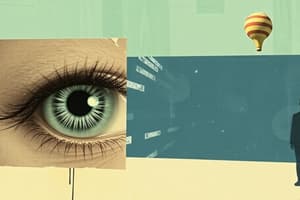Podcast
Questions and Answers
What is the function of photoreceptors in the process of vision?
What is the function of photoreceptors in the process of vision?
- Interpret visual information
- Focus light onto the retina
- Convert electrical signals into light
- Convert light into electrical signals (correct)
How do optical illusions often trick our brains?
How do optical illusions often trick our brains?
- By causing depth perception issues
- By showing images that differ from their true nature (correct)
- By providing expected outcomes
- By presenting clear and unambiguous patterns
Where does the process of vision begin in the eye?
Where does the process of vision begin in the eye?
- Optic nerve
- Retina
- Cornea (correct)
- Pupil
What causes binocular disparity in visual perception?
What causes binocular disparity in visual perception?
Which part of the brain is responsible for interpreting electrical signals from the optic nerve as images?
Which part of the brain is responsible for interpreting electrical signals from the optic nerve as images?
Which famous drawing plays on our understanding of space and distance, appearing to go both upwards and downwards simultaneously?
Which famous drawing plays on our understanding of space and distance, appearing to go both upwards and downwards simultaneously?
What type of illusion exploits the way our brains interpret color, causing a single color to transform into another in certain lighting conditions?
What type of illusion exploits the way our brains interpret color, causing a single color to transform into another in certain lighting conditions?
Which aspect of visual processing involves the brain creating a mental representation of the scene observed by receiving electrical signals from the retina?
Which aspect of visual processing involves the brain creating a mental representation of the scene observed by receiving electrical signals from the retina?
What effect occurs after staring at bright colors or shapes for an extended period, with the images appearing to continue in peripheral vision?
What effect occurs after staring at bright colors or shapes for an extended period, with the images appearing to continue in peripheral vision?
In split-brain patients, which hemisphere is primarily responsible for language abilities, including understanding spoken and written language?
In split-brain patients, which hemisphere is primarily responsible for language abilities, including understanding spoken and written language?
Flashcards are hidden until you start studying
Study Notes
Vision
Vision is one of the five basic senses, allowing us to perceive the world around us through sight. It involves several complex processes that enable us to interpret visual information and make sense of our surroundings. The process of vision begins with light entering the eye through the cornea and pupil, then being focused onto the retina, where specialized cells called photoreceptors convert the light into electrical signals. These signals are sent along the optic nerve to the brain, specifically the primary visual cortex, where they are interpreted as images. This intricate system allows us to see various colors, shapes, sizes, and distances.
Optical Illusions
Optical illusions are visual phenomena that occur when our perception of an image is different from its true nature. They often involve ambiguous patterns, contradictory information, or unexpected outcomes, which can trick our brains into seeing something other than what is actually there. Some common types of optical illusions include:
Binocular Disparity
Binocular disparity occurs when two slightly different images are presented to each eye, causing depth perception issues. For example, looking at a three-dimensional object from different angles causes the eyes to receive slightly different images due to their separation, leading to an illusion of the object changing size or shape.
Perspective Illusion
Perspective illusions play on our understanding of space and distance, creating unusual visual effects. One famous example is Escher's staircase drawing, which appears to go both upwards and downwards simultaneously.
Color Illusions
Color illusions exploit the way our brains interpret color, such as the "color constancy" illusion, where a single color transforms into another in certain lighting conditions.
Afterimages
Afterimages are temporary visual effects occurring after staring at bright colors or shapes for an extended period. When you look away, these images appear to continue in your peripheral vision, often slightly altered in appearance.
Visual Processing
Visual processing refers to how the brain interprets and uses visual information received from the eyes. It involves several stages of analysis, including receiving the raw data, organizing it into recognizable patterns, and integrating this information with other senses. Key aspects of visual processing include:
Light Perception
Light perception starts with the photoreceptor cells in the retina detecting light, converting it into electrical signals that are transmitted via the optic nerve to the brain.
Image Formation
Image formation occurs when the brain receives the electrical signals from the retina and uses them to create a mental representation of the scene observed.
Object Recognition
Object recognition involves analyzing the features and characteristics of objects, allowing us to identify familiar items or understand unfamiliar ones. This helps us navigate our environment effectively.
Depth Perception
Depth perception enables us to judge relative distances between objects and assess how far away things are. This skill combines information from our eyes (binocular cues), head movements, and motion parallax to create a sense of spatial location.
Half’s Brain
Half's Brain, also known as split-brain research, is a term used to describe studies conducted on patients who have undergone hemispherectomy, a surgical procedure involving the removal of one cerebral hemisphere usually because of severe epilepsy. Researchers found that the remaining hemisphere could still function relatively normally, despite losing direct communication with the opposite side of the body.
Split-brain research has provided valuable insights into the functions of each cerebral hemisphere:
- Language: Most language abilities are located in the left hemisphere. In split-brain patients, the left hemisphere can still understand spoken and written language, but without the ability to speak or write.
- Spatial Perception: The right hemisphere typically controls spatial perception, which is why patients with the left hemisphere removed experience difficulty navigating narrow passages or finding their way in unfamiliar environments.
- Visual Perception: While the left hemisphere is better at recognizing faces, the right hemisphere tends to process visual information more holistically.
Despite these findings, it is important to note that the brain is highly plastic and capable of reorganizing itself to compensate for the loss of one hemisphere. After a period of adaptation, split-brain patients can often regain some of the lost skills, albeit with varying degrees of success.
Studying That Suits You
Use AI to generate personalized quizzes and flashcards to suit your learning preferences.




